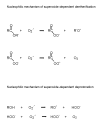New nucleophilic mechanisms of ros-dependent epigenetic modifications: comparison of aging and cancer
- PMID: 24490117
- PMCID: PMC3901614
- DOI: 10.14336/AD.2014.050052
New nucleophilic mechanisms of ros-dependent epigenetic modifications: comparison of aging and cancer
Abstract
It has been shown that ROS (reactive oxygen species, superoxide and hydrogen peroxide) regulate major epigenetic processes, DNA methylation and histone acetylation, although the mechanism of ROS action (ROS signaling) is still unknown. Both DNA methylation and histone acetylation are nucleophilic processes and therefore ROS signaling through typical free radical processes, for example hydrogen atom abstraction is impossible. However, being "super-nucleophile" superoxide can participate in these reactions. Now we propose new nucleophilic mechanisms of DNA methylation and histone modification. During DNA methylation superoxide can deprotonate the cytosine molecule at C-5 position and by this accelerate the reaction of DNA with the positive-charged intermediate S-adenosyl-L-methionine (SAM). Superoxide can also deprotonate histone N-terminal tail lysines and accelerate the formation of their complexes with acetyl-coenzyme A (AcCoA), the supplier of acetyl groups. In cancer cells ROS enhance DNA methylation causing the silencing of tumor suppressor and antioxidant genes and enhancing the proliferation of cancer cells under condition of oxidative stress. ROS signaling in senescent cells probably causes DNA hypomethylation although there are insufficient data for such proposal.
Keywords: DNA Methylation; Histone Modification; Nucleophilic Mechanisms; ROS.
Figures





References
-
- Afanas’ev I. Nucleophilic mechanism of ROS/RNS signaling in cancer epigenetic modifications. Am J Biomed Sci. 2012;4:285–306.
-
- Afanas’ev IB. Superoxide Ion: Chemistry and Biological Implications. Vol. 1. CRC Press; Boca Raton, Florida: 1989. pp. 1–279.
-
- Afanas’ev IB. On mechanism of superoxide signaling under physiological and pathophysiological conditions. Med Hypotheses. 2005;64:127–9. - PubMed
-
- Afanas’ev IB. Competition between superoxide and hydrogen peroxide signaling in heterolytic enzymatic processes. Med Hypotheses. 2006;66:1125–8. - PubMed
-
- Afanas’ev IB. Signaling functions of free radicals superoxide & nitric oxide under physiological & pathological conditions. Mol Biotechnol. 2007;37:2–4. - PubMed
Publication types
LinkOut - more resources
Full Text Sources
Other Literature Sources
Miscellaneous
